
|
Now it is bright as 8.6 mag (Oct. 15, Chris Wyatt). It is observable at 8 mag for a long time from 2022 to 2023. In the Southern Hemisphere, it stays observable for a long time, although it becomes low temporarily from November to December. In the Northern Hemisphere, it is not observable until 2023 summer.
Date(TT) R.A. (2000) Decl. Delta r Elong. m1 Best Time(A, h)
Oct. 22 16 11.33 -39 30.2 2.548 1.947 43 8.2 18:41 ( 46, -7)
Oct. 29 16 18.03 -41 46.5 2.573 1.915 39 8.2 18:34 ( 46,-11)
|
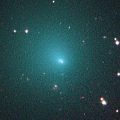
|
Now it is very bright as 9.9 mag (Oct. 15, Chris Wyatt). It stays 10 mag until November. In the Northern Hemisphere, it becomes unobservable soon. In the Southern Hemisphere, it becomes unobservable temporarily from December to January.
Date(TT) R.A. (2000) Decl. Delta r Elong. m1 Best Time(A, h)
Oct. 22 20 55.64 -42 24.7 1.248 1.668 95 10.1 18:51 ( 0, 13)
Oct. 29 20 27.69 -42 7.5 1.417 1.643 84 10.2 18:34 ( 7, 13)
|
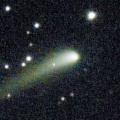
|
Now it is bright as 11.1 mag (Oct. 21, Osamu Miyazaki). It will approach to Earth down to 0.29 a.u. in 2023 February, and it is expected to brighten up to 5 mag. In the Northern Hemisphere, it stays observable in excellent condition for a long time, although it becomes extremely low temporarily in November. In the Southern Hemisphere, it is not observable until early February.
Date(TT) R.A. (2000) Decl. Delta r Elong. m1 Best Time(A, h)
Oct. 22 15 50.20 25 32.2 2.211 1.704 47 11.0 18:41 (103, 27)
Oct. 29 15 49.66 25 0.4 2.169 1.628 45 10.8 18:34 (105, 23)
|
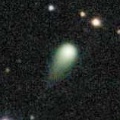
|
Now it is 11.6 mag (Oct. 19, Osamu Miyazaki). It is expected to brighten up to 10 mag in 2023. In the Northern Hemisphere, it stays observable in good condition until 2023 autumn. In the Southern Hemipshere, it stays unobservable until 2023 summer.
Date(TT) R.A. (2000) Decl. Delta r Elong. m1 Best Time(A, h)
Oct. 22 11 0.47 57 58.1 3.218 3.139 76 11.5 4:47 (221, 43)
Oct. 29 11 4.93 59 44.3 3.064 3.087 82 11.3 4:52 (218, 46)
|

|
It brightened up to 8.3 mag in last winter (Jan. 6, Toshiyuki Takahashi). Now it is fading. But it is bright as 12.2 mag still now (Oct. 20, Osamu Miyazaki).
Date(TT) R.A. (2000) Decl. Delta r Elong. m1 Best Time(A, h)
Oct. 22 9 46.17 -15 55.7 4.821 4.378 58 11.5 4:47 (312, 24)
Oct. 29 9 49.99 -17 27.8 4.775 4.413 62 11.6 4:52 (320, 27)
|
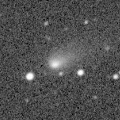
|
Now it is 11.6 mag (Oct. 15, Ken-ichi Kadota). It will appear in the morning sky in November also in the Southern Hemisphere. It stays 11-12 mag until spring.
Date(TT) R.A. (2000) Decl. Delta r Elong. m1 Best Time(A, h)
Oct. 22 11 17.15 5 2.5 2.322 1.687 40 12.0 4:47 (279, 21)
Oct. 29 11 35.97 3 12.5 2.266 1.667 42 11.9 4:52 (283, 23)
|
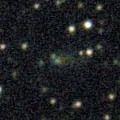
|
Now it is 12.8 mag (Oct. 1, Thomas Lehmann). It is expected to brighten very rapidly up to 11-12 mag in winter, and it will be observable in excellent condition.
Date(TT) R.A. (2000) Decl. Delta r Elong. m1 Best Time(A, h)
Oct. 22 7 37.05 10 28.2 1.495 1.851 93 12.4 4:47 (332, 63)
Oct. 29 7 49.28 9 49.8 1.425 1.843 97 12.2 4:52 (344, 64)
|

|
Now it is 13.1 mag (Oct. 2, Toshihiko Ikemura, Hirohisa Sato). It is expected to brighten up to 11 mag in 2023. In the Northern Hemisphere, it will be unobservable in November. In the Southern Hemisphere, it stays observable in good condition for a long time, although it becomes unobservable temporarily from November to January.
Date(TT) R.A. (2000) Decl. Delta r Elong. m1 Best Time(A, h)
Oct. 22 17 25.02 -12 39.7 4.124 3.626 53 12.3 18:41 ( 54, 23)
Oct. 29 17 28.99 -14 5.4 4.182 3.591 47 12.3 18:34 ( 56, 19)
|
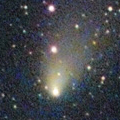
|
It brightened up to 10.4 mag from June to July (July 22, Ken-ichi Kadota). Appearing in the morning sky in the Souther Hemisphere. It will never be observable again in the Northern Hemisphere.
Date(TT) R.A. (2000) Decl. Delta r Elong. m1 Best Time(A, h)
Oct. 22 13 20.05 -44 41.8 2.430 1.702 34 12.4 4:47 (306,-29)
Oct. 29 13 42.11 -48 13.6 2.494 1.781 35 12.7 4:52 (311,-29)
|
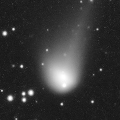
|
Now it is bright as 12.8 mag (Aug. 28, Hiroshi Abe). It stays 12 mag for a while. It becomes unobservable from August to November in the Northern Hemisphere, or from September to December in the Southern Hemisphere.
Date(TT) R.A. (2000) Decl. Delta r Elong. m1 Best Time(A, h)
Oct. 22 13 53.35 -3 5.4 5.371 4.388 8 12.7 18:41 ( 95,-12)
Oct. 29 14 1.07 -3 4.1 5.376 4.403 10 12.7 4:52 (267,-10)
|
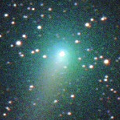
|
It brightened up to 9.3 mag in early summer (June 5, Chris Wyatt). Now it is fading. It has already faded down to 12.4 mag (Oct. 1, Thomas Lehmann). In the Southen Hemisphere, it stays observable in good condition for a long time. In the Northern Hemisphere, it will be observable after November.
Date(TT) R.A. (2000) Decl. Delta r Elong. m1 Best Time(A, h)
Oct. 22 10 12.81 -40 31.6 2.854 2.427 55 13.0 4:47 (324, 1)
Oct. 29 10 10.63 -41 5.4 2.845 2.484 59 13.1 4:52 (329, 4)
|
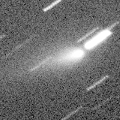
|
Outburst occured in early October. Now it is very bright as 10.4 mag (Oct. 15, Chris Wyatt). It stays observable in good condition in the Southern Hemisphere. It locates low in the Northern Hemisphere. Michael Jager detected several fragments at 17.5-19 mag.
Date(TT) R.A. (2000) Decl. Delta r Elong. m1 Best Time(A, h)
Oct. 22 18 57.13 -35 44.6 1.089 1.257 74 13.2 18:41 ( 22, 15)
Oct. 29 19 35.93 -34 37.0 1.153 1.316 75 13.6 18:34 ( 18, 18)
|

|
Now it is 15.5 mag (Oct. 20, ATLAS-MLO, Mauna Loa). It is expected to brighten up to 12 mag from winter to summer in 2023. In the Northern Hemisphere, it stays observable in good condition until 2023 spring. In the Southern Hemisphere, it stays observable in good condition for a long time after this. It is fainter than this ephemeris recently.
Date(TT) R.A. (2000) Decl. Delta r Elong. m1 Best Time(A, h)
Oct. 22 5 9.93 27 25.0 2.273 3.003 129 13.6 3:10 ( 0, 83)
Oct. 29 5 4.38 25 22.6 2.135 2.947 137 13.3 2:37 ( 0, 80)
|
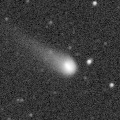
|
Now it is 13.7 mag (Sept. 24, Hiroshi Abe). It is expected to brighten up to 12 mag in 2023. In the Northern Hemisphere, it stays observable in good condition for a long time, although it becomes unobservable temporarily in October. In the Southern Hemisphere, it is not observable until mid December. But it will be observable in good condition in 2023.
Date(TT) R.A. (2000) Decl. Delta r Elong. m1 Best Time(A, h)
Oct. 22 13 39.15 12 34.8 4.788 3.895 23 13.4 4:47 (252, -3)
Oct. 29 13 41.53 11 29.3 4.743 3.873 25 13.3 4:52 (258, 2)
|
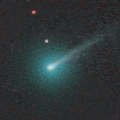
|
It brightened rapidly up to 12.4 mag in early October (Oct. 2, Michael Jager). Then it became fainter a bit, 13.0 mag (Oct. 9, Michael Jager). Although it is a tiny comet, it will approach to Sun down to 0.63 a.u. on Oct. 25. In the Northern Hemisphere, it is observable until late October. In the Southern Hemisphere, it is not observable after this.
Date(TT) R.A. (2000) Decl. Delta r Elong. m1 Best Time(A, h)
Oct. 22 12 58.28 19 34.5 1.183 0.636 32 13.4 4:47 (252, 9)
Oct. 29 13 41.93 14 11.1 1.302 0.638 28 13.6 4:52 (255, 4)
|

|
Now it is 13.6 mag (Sept. 30. Hiroshi Abe).
Date(TT) R.A. (2000) Decl. Delta r Elong. m1 Best Time(A, h)
Oct. 22 6 58.91 29 0.9 5.697 6.035 105 13.6 4:47 (336, 83)
Oct. 29 6 59.25 29 3.7 5.593 6.037 112 13.6 4:32 ( 0, 84)
|

|
The condition is worst in this apparition. It is not observable at all.
Date(TT) R.A. (2000) Decl. Delta r Elong. m1 Best Time(A, h)
Oct. 22 15 9.52 -12 24.4 2.048 1.171 20 13.8 18:41 ( 76, -2)
Oct. 29 15 37.46 -14 16.8 2.090 1.214 20 14.4 18:34 ( 73, -1)
|

|
Now it is 14.7 mag (Oct. 14, Chris Wyatt). It stays observable at 13-14 mag for a while.
Date(TT) R.A. (2000) Decl. Delta r Elong. m1 Best Time(A, h)
Oct. 22 19 8.90 -30 14.7 3.156 3.085 76 14.3 18:41 ( 22, 21)
Oct. 29 19 17.73 -29 52.1 3.253 3.091 71 14.4 18:34 ( 24, 21)
|

|
Now it is 15.0 mag (Oct. 2, Ken-ichi Kadota). The brightness evolution is slower than originally expected. It stays 14-15 mag for a long time. It locates extremely low in the Northern Hemisphere. In the Southern Hemisphere, it will be unobservable temporarily in November.
Date(TT) R.A. (2000) Decl. Delta r Elong. m1 Best Time(A, h)
Oct. 22 16 54.67 -24 25.4 3.567 2.978 46 14.6 18:41 ( 51, 10)
Oct. 29 16 58.86 -23 4.9 3.668 2.987 40 14.7 18:34 ( 55, 8)
|
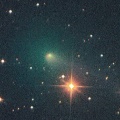
|
Now it is 14.5 mag (Oct. 14, Chris Wyatt). It stays observable in good condition after this. But it will be fading gradually after this.
Date(TT) R.A. (2000) Decl. Delta r Elong. m1 Best Time(A, h)
Oct. 22 1 0.06 -1 45.4 1.562 2.531 163 14.7 22:56 ( 0, 53)
Oct. 29 0 55.06 -2 5.2 1.636 2.574 155 15.0 22:24 ( 0, 53)
|
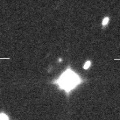
|
Now it is 14.3 mag (Oct. 15, Ken-ichi Kadota). It is expected to brighten up to 12.5 mag in winter. In the Northern Hemisphere, it will be observable in good condition after this. In the Southern Hemisphere, it is not observable until 2023 June.
Date(TT) R.A. (2000) Decl. Delta r Elong. m1 Best Time(A, h)
Oct. 22 12 21.61 20 1.9 3.018 2.304 37 15.0 4:47 (257, 16)
Oct. 29 12 32.45 21 15.7 2.882 2.249 42 14.8 4:52 (259, 21)
|
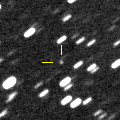
|
Now it is 14.7 mag (Oct. 15, Ken-ichi Kadota). It stays 14 mag in 2023. In the Southern Hemisphere, it stays observable in good condition for a long time. It locates somewhat low in the Northern Hemisphere.
Date(TT) R.A. (2000) Decl. Delta r Elong. m1 Best Time(A, h)
Oct. 22 6 15.17 -19 37.1 3.419 3.828 106 15.0 4:15 ( 0, 35)
Oct. 29 6 5.62 -20 46.3 3.291 3.794 113 14.9 3:38 ( 0, 34)
|
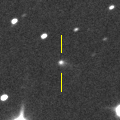
|
Now it is 16.3 mag (Oct. 16, ATLAS-MLO, Mauna Loa). It will brighten up to 14 mag in early 2023, and it will be observable in good condition. It is fainter than this ephemeris recently.
Date(TT) R.A. (2000) Decl. Delta r Elong. m1 Best Time(A, h)
Oct. 22 8 51.81 16 29.4 3.603 3.524 77 15.1 4:47 (296, 57)
Oct. 29 8 59.10 16 29.5 3.489 3.505 82 15.0 4:52 (304, 61)
|
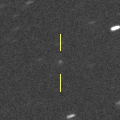
|
It will brighten up to 13 mag in winter. But the condition is bad. It is not observable until February in the Southern Hemisphere, or until May in the Northern Hemisphere.
Date(TT) R.A. (2000) Decl. Delta r Elong. m1 Best Time(A, h)
Oct. 22 14 11.54 -10 50.0 2.796 1.811 6 15.2 18:41 ( 85,-13)
Oct. 29 14 28.70 -12 38.5 2.771 1.781 4 15.1 18:34 ( 84,-14)
|
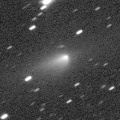
|
It brightened up to 12.7 mag in early 2022 (Feb. 27, Toshihiko Ikemura, Hirohisa Sato). Now it is fading. Now it is not observable. It will be observable agin at 16 mag in January in the Southern Hemisphere, or in February in the Northern Hemisphere.
Date(TT) R.A. (2000) Decl. Delta r Elong. m1 Best Time(A, h)
Oct. 22 14 35.86 -16 27.0 3.255 2.299 13 15.1 18:41 ( 77,-11)
Oct. 29 14 50.46 -17 38.4 3.284 2.314 10 15.2 18:34 ( 77,-13)
|
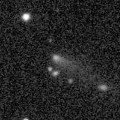
|
Now it is 14.7 mag (Oct. 17, Michael Jager). It stays 15 mag and observable in excellent condition until December.
Date(TT) R.A. (2000) Decl. Delta r Elong. m1 Best Time(A, h)
Oct. 22 2 35.85 20 11.8 1.447 2.421 164 15.1 0:37 ( 0, 75)
Oct. 29 2 29.45 21 15.5 1.434 2.420 170 15.1 0:03 ( 0, 76)
|

|
Now it is 14.9 mag (Oct. 13, ATLAS South Africa). It was expected to brighten up to 13 mag in spring. But actually, it was fainter than originally expected. In the Southern Hemisphere, it stays observable in good condition for a long time. In the Northern Hemisphere, it stays extremely low for a while.
Date(TT) R.A. (2000) Decl. Delta r Elong. m1 Best Time(A, h)
Oct. 22 5 35.77 -52 39.1 3.047 3.361 99 15.2 3:36 ( 0, 2)
Oct. 29 5 16.14 -53 25.1 3.027 3.386 102 15.2 2:49 ( 0, 2)
|
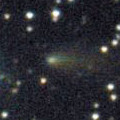
|
Now it is 14.8 mag (Oct. 3, Ken-ichi Kadota). It stays observable in good condition at 15 mag from summer to winter. It locates somwwhat low in the Southern Hemisphere.
Date(TT) R.A. (2000) Decl. Delta r Elong. m1 Best Time(A, h)
Oct. 22 7 43.20 19 6.7 2.094 2.380 93 15.4 4:47 (318, 70)
Oct. 29 7 50.53 19 2.0 2.021 2.390 99 15.3 4:52 (335, 73)
|
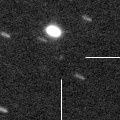
|
Now it is 15.0 mag (Oct. 17, Michael Jager). It is expected to brighten up to 8 mag in 2023 July. In 2022, it stays observable in good condition while the comet will be brightening gradually.
Date(TT) R.A. (2000) Decl. Delta r Elong. m1 Best Time(A, h)
Oct. 22 2 31.89 -4 52.1 2.851 3.803 160 15.6 0:33 ( 0, 50)
Oct. 29 2 18.97 -6 24.9 2.785 3.735 160 15.4 23:47 ( 0, 49)
|
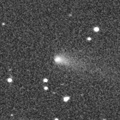
|
Now it is 14.6 mag (Oct. 19, Toshihiko Ikemura, Hirohisa Sato). It stays 15 mag until November, and it stays observable in good condition.
Date(TT) R.A. (2000) Decl. Delta r Elong. m1 Best Time(A, h)
Oct. 22 1 24.32 0 57.5 1.141 2.126 168 15.6 23:21 ( 0, 56)
Oct. 29 1 21.00 0 20.4 1.159 2.126 161 15.6 22:50 ( 0, 55)
|
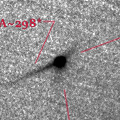
|
Due to the DART spacecraft impact to its satellite Dimorphos on Sept. 26, the cometary activity was detected. It brightened up to 12.9 mag (Sept. 28, John Drummond). It stays bright and observable in good condition until mid January
Date(TT) R.A. (2000) Decl. Delta r Elong. m1 Best Time(A, h)
Oct. 22 7 7.43 -3 4.1 0.091 1.013 98 15.8 4:47 (352, 51)
Oct. 29 7 36.28 3 22.2 0.105 1.016 99 16.0 4:52 (353, 58)
|
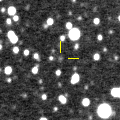
|
Now it is 16.5 mag (Oct. 20, ATLAS South Africa). It will brighten up to 13 mag from 2024 to 2025.
Date(TT) R.A. (2000) Decl. Delta r Elong. m1 Best Time(A, h)
Oct. 22 9 3.80 -31 12.0 7.459 7.139 67 16.0 4:47 (330, 16)
Oct. 29 9 6.69 -31 59.1 7.357 7.104 71 15.9 4:52 (336, 18)
|
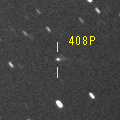
|
Now it is 16.6 mag (Oct. 20, ATLAS-HKO, Haleakala). It will be observable at 16-17 mag in excellent condition from autumn to winter.
Date(TT) R.A. (2000) Decl. Delta r Elong. m1 Best Time(A, h)
Oct. 22 4 37.33 2 52.1 2.678 3.468 136 16.1 2:37 ( 0, 58)
Oct. 29 4 35.34 2 1.7 2.626 3.469 142 16.1 2:08 ( 0, 57)
|
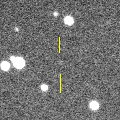
|
Now it is 16.1 mag (Oct. 14, ATLAS Chile). It is expected to brighten up to 7 mag in early 2024. In the Southern Hemisphere, it stays observable in good condition for a long time. In the Northern Hemisphere, it stays low in 2022.
Date(TT) R.A. (2000) Decl. Delta r Elong. m1 Best Time(A, h)
Oct. 22 6 20.93 -30 43.9 5.433 5.722 101 16.3 4:20 ( 0, 24)
Oct. 29 6 20.09 -31 51.6 5.314 5.659 105 16.2 3:52 ( 0, 23)
|
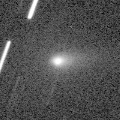
|
It brightened rapidly as predicted, and it brightened up to 14.0 mag in September (Sept. 22, Michael Jager). Now it is fading. But it is bright as 15.4 mag still now (Oct. 14, Chris Wyatt). It will be fainter than 18 mag in December.
Date(TT) R.A. (2000) Decl. Delta r Elong. m1 Best Time(A, h)
Oct. 22 2 17.22 -35 21.9 0.787 1.637 133 16.3 0:18 ( 0, 20)
Oct. 29 2 16.30 -37 43.7 0.845 1.661 128 16.5 23:45 ( 0, 17)
|
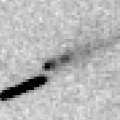
|
Now it is 16.1 mag (Sept. 23, Michael Jager). It stays observable at 16 mag from summer to winter. It will be getting higher after this also in the Southern Hemisphere. Michael Jager discovered a 18-mag fragment.
Date(TT) R.A. (2000) Decl. Delta r Elong. m1 Best Time(A, h)
Oct. 22 9 38.10 13 58.0 1.756 1.630 66 16.3 4:47 (288, 46)
Oct. 29 9 53.12 11 48.0 1.723 1.649 68 16.4 4:52 (294, 48)
|
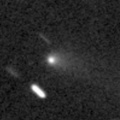
|
Now it is 15.8 mag (Oct. 2, Toshihiko Ikemura, Hirohisa Sato). Now it is fading. It stays 13-14 mag for a while. It is observable in excellent condition in the Southern Hemisphere. It locates somewhat low in the Northern Hemisphere.
Date(TT) R.A. (2000) Decl. Delta r Elong. m1 Best Time(A, h)
Oct. 22 22 18.34 -25 19.4 1.917 2.541 118 16.5 20:16 ( 0, 30)
Oct. 29 22 20.78 -24 22.5 2.036 2.581 112 16.7 19:51 ( 0, 31)
|
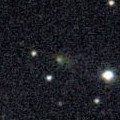
|
Now it is 16.5 mag (Oct. 1, Ken-ichi Kadota). It will be observable at 16-17 mag in good condition from summer to autumn.
Date(TT) R.A. (2000) Decl. Delta r Elong. m1 Best Time(A, h)
Oct. 22 3 33.87 27 28.4 1.600 2.509 149 16.6 1:35 ( 0, 83)
Oct. 29 3 28.71 27 9.8 1.590 2.535 157 16.6 1:02 ( 0, 82)
|
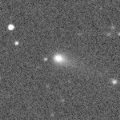
|
Now it is 16.1 mag (Oct. 12, ATLAS-HKO, Haleakala). It continued brightening even after the perihelion passage. It stays observable at 16 mag in good condition for a while.
Date(TT) R.A. (2000) Decl. Delta r Elong. m1 Best Time(A, h)
Oct. 22 22 57.48 -3 20.8 3.573 4.344 135 16.7 20:54 ( 0, 52)
Oct. 29 22 56.84 -3 31.7 3.664 4.356 128 16.8 20:26 ( 0, 52)
|

|
It brightened up to 14 mag in 2021. Now it is fading. It has already faded down to 15.7 mag (Oct. 17, W. Pei). It is observable at 16-17 mag in 2022.
Date(TT) R.A. (2000) Decl. Delta r Elong. m1 Best Time(A, h)
Oct. 22 23 24.87 15 10.0 5.464 6.311 145 16.7 21:22 ( 0, 70)
Oct. 29 23 22.09 15 6.6 5.567 6.349 138 16.8 20:51 ( 0, 70)
|
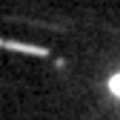
|
It will brighten rapidly up to 14 mag in spring. In the Southern Hemisphere, it will appear in the morning sky in December, and it will be observable in excellent condition in spring. In the Northern Hemisphere, it is observable in good condition in winter, but it becomes somewhat low in spring.
Date(TT) R.A. (2000) Decl. Delta r Elong. m1 Best Time(A, h)
Oct. 22 12 4.39 10 2.3 3.359 2.577 32 16.9 4:47 (268, 14)
Oct. 29 12 15.17 8 26.5 3.293 2.559 36 16.8 4:52 (272, 18)
|

|
Now it is 15.8 mag (Oct. 19, Toshihiko Ikemura, Hirohisa Sato). It brightened up to 14 mag from 2020 to 2021. Now it is fading slowly. It is observable at 16-17 mag in 2022.
Date(TT) R.A. (2000) Decl. Delta r Elong. m1 Best Time(A, h)
Oct. 22 0 13.41 -20 5.4 3.201 4.030 141 16.8 22:10 ( 0, 35)
Oct. 29 0 10.10 -19 55.4 3.280 4.047 135 16.9 21:39 ( 0, 35)
|
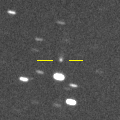
|
Now it is 17.7 mag (July 9, ATLAS Chile). It will brighten up to 16 mag in 2023. In the Southern Hemisphere, it stays observable in good condition for a long time, although it became low temporarily from August to October. In the Northern Hemisphere, it will never be observable again.
Date(TT) R.A. (2000) Decl. Delta r Elong. m1 Best Time(A, h)
Oct. 22 12 10.30 -39 55.1 4.169 3.412 35 16.9 4:47 (308,-16)
Oct. 29 12 21.58 -41 50.0 4.129 3.392 37 16.9 4:52 (312,-13)
|

|
It brightened up to 14.2 mag in 2021 summer (July 18, 2021, Taras Prystavski). Now it is fading. It has already faded down to 16.5 mag (Oct. 19, Hirohisa Sato). In the Southern Hemisphere, it stays observable in good condition for a long time. It locates somewhat low in the Northern Hemisphere.
Date(TT) R.A. (2000) Decl. Delta r Elong. m1 Best Time(A, h)
Oct. 22 1 42.00 -26 31.4 4.720 5.544 142 17.1 23:38 ( 0, 29)
Oct. 29 1 36.95 -26 8.2 4.792 5.587 139 17.1 23:06 ( 0, 29)
|

|
Now it is 16.8 mag (Oct. 1, ATLAS-MLO, Mauna Loa). Fading slowly. In the Northern Hemisphere, it stays observable in good condition for a long time. In the Southern Hemisphere, it is not observable after this.
Date(TT) R.A. (2000) Decl. Delta r Elong. m1 Best Time(A, h)
Oct. 22 17 13.04 63 27.8 9.508 9.459 84 17.1 18:41 (148, 47)
Oct. 29 17 15.66 63 10.8 9.521 9.473 84 17.1 18:34 (147, 45)
|

|
It brightened very rapidly up to 15.5 mag from last autumn to last winter (Nov. 2, 2021, Toshihiko Ikemura, Hirohisa Sato). Now it is fading slowly. It has already faded down to 16.9 mag (Oct. 20, ATLAS-HKO, Haleakala).
Date(TT) R.A. (2000) Decl. Delta r Elong. m1 Best Time(A, h)
Oct. 22 6 48.46 12 18.9 3.903 4.284 105 17.1 4:47 (359, 67)
Oct. 29 6 49.38 11 52.4 3.823 4.302 112 17.1 4:22 ( 0, 67)
|
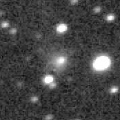
|
Now it is 17.3 mag (Oct. 19, Toshihiko Ikemura, Hirohisa Sato). It stayed bright for a while even after the perihelion passage, but it will be fading after this. It will be fainter than 18 mag in winter.
Date(TT) R.A. (2000) Decl. Delta r Elong. m1 Best Time(A, h)
Oct. 22 21 15.45 0 43.7 6.808 7.245 112 17.1 19:13 ( 0, 56)
Oct. 29 21 14.23 -0 4.4 6.949 7.272 105 17.2 18:44 ( 0, 55)
|
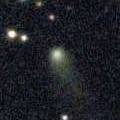
|
Now it is 16.6 mag (Oct. 2, Toshihiko Ikemura, Hirohisa Sato). Fading slowly. In the Southern Hemisphere, it is not observable after this.
Date(TT) R.A. (2000) Decl. Delta r Elong. m1 Best Time(A, h)
Oct. 22 16 11.07 37 45.3 6.026 5.586 59 17.1 18:41 (114, 36)
Oct. 29 16 17.90 37 39.3 6.063 5.615 58 17.2 18:34 (115, 34)
|
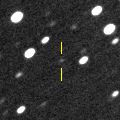
|
Now it is 17.8 mag (July 8, ATLAS Chile). It is expected to brighten up to 12-13 mag from 2024 to 2025.
Date(TT) R.A. (2000) Decl. Delta r Elong. m1 Best Time(A, h)
Oct. 22 10 31.50 -18 34.2 7.486 6.850 47 17.2 4:47 (306, 14)
Oct. 29 10 32.80 -18 48.1 7.361 6.805 52 17.2 4:52 (312, 19)
|
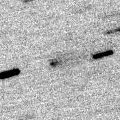
|
Now it is 18.0 mag (Oct. 2, M. Jaeger, E. Prosperi, S. Prosperi). It stays observable at 17 mag until winter. It will become observable in good condition also in the Southern Hemisphere.
Date(TT) R.A. (2000) Decl. Delta r Elong. m1 Best Time(A, h)
Oct. 22 9 17.25 15 45.7 2.298 2.194 71 17.2 4:47 (290, 51)
Oct. 29 9 27.10 14 26.1 2.246 2.220 75 17.2 4:52 (298, 55)
|
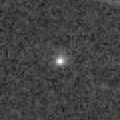
|
Now it is 16.6 mag (Oct. 19, Toshihiko Ikemura, Hirohisa Sato). It stays observable at 17-18 mag until next summer. It may be brighter than this ephemeris.
Date(TT) R.A. (2000) Decl. Delta r Elong. m1 Best Time(A, h)
Oct. 22 23 15.87 -14 56.3 1.268 2.094 134 17.2 21:10 ( 0, 40)
Oct. 29 22 41.70 -15 18.8 1.347 2.042 120 17.2 20:09 ( 0, 40)
|
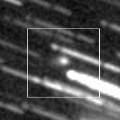
|
Now it is 16.8 mag (Oct. 19, Toshihiko Ikemura, Hirohisa Sato). It is expected to brighten up to 11-12 mag in 2024. In the Northern Hemisphere, it stays observable in good condition for a long time until 2023 autumn, although it becomes temporarily low in December. In the Southern Hemisphere, it becomes unobservable soon. But it will be observable in excellent condition at the high light.
Date(TT) R.A. (2000) Decl. Delta r Elong. m1 Best Time(A, h)
Oct. 22 17 55.64 21 2.6 5.832 5.559 69 17.3 18:41 ( 81, 51)
Oct. 29 17 56.30 20 4.6 5.862 5.507 64 17.2 18:34 ( 83, 46)
|
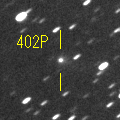
|
It brightened up to 15.3 mag in last winter (Jan. 12, H. Nohara). Now it is fading. It has already faded down to 17.7 mag (Oct. 3, Catalina Sky Survey). It will be observable at 17 mag in good condition in next winter. It locates low in the Southern Hemisphere.
Date(TT) R.A. (2000) Decl. Delta r Elong. m1 Best Time(A, h)
Oct. 22 9 54.79 18 13.7 4.657 4.311 63 17.3 4:47 (280, 45)
Oct. 29 10 0.47 18 18.3 4.573 4.327 69 17.3 4:52 (285, 51)
|

|
It approached to Sun down to 0.14 a.u. on May 15. But it was not observable around that time. In the Northern Hemisphere, it stays observable at 17-18 mag in good condition from July to November. In the Southern Hemisphere, it stays extremely low.
Date(TT) R.A. (2000) Decl. Delta r Elong. m1 Best Time(A, h)
Oct. 22 2 30.89 44 52.3 1.268 2.158 144 17.3 0:33 (180, 80)
Oct. 29 2 9.03 43 15.8 1.274 2.191 149 17.3 23:36 (180, 82)
|
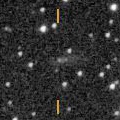
|
Now it is 17.1 mag (Oct. 3, Ken-ichi Kadota). In the Northern Hemisphere, it stays observable at 17 mag in good condition for a long time until winter. In the Southern Hemisphere, it stays extremely low for a long time.
Date(TT) R.A. (2000) Decl. Delta r Elong. m1 Best Time(A, h)
Oct. 22 7 48.49 47 13.6 2.561 2.864 97 17.4 4:47 (219, 73)
Oct. 29 7 57.26 47 39.7 2.504 2.882 102 17.4 4:52 (206, 76)
|

|
Now it is 17.2 mag (Oct. 16, ATLAS-MLO, Mauna Loa). It stays observable at 17-18 mag in 2022. It locates somewhat low in the Southern Hemisphere.
Date(TT) R.A. (2000) Decl. Delta r Elong. m1 Best Time(A, h)
Oct. 22 1 23.00 25 44.3 4.585 5.549 164 17.4 23:19 ( 0, 81)
Oct. 29 1 13.37 24 45.7 4.610 5.563 162 17.4 22:42 ( 0, 80)
|

|
It brightened up to 12.3 mag from spring to summer in 2021 (June 15, 2021, Marco Goiato). Now it is fading. It has already faded down to 15.9 mag (July 19, ATLAS-MLO, Mauna Loa). It will be fainter than 18 mag in January.
Date(TT) R.A. (2000) Decl. Delta r Elong. m1 Best Time(A, h)
Oct. 22 12 32.31 28 53.0 6.585 5.902 43 17.5 4:47 (248, 19)
Oct. 29 12 34.91 29 10.5 6.560 5.948 48 17.5 4:52 (251, 25)
|
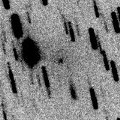
|
Now it is 17.4 mag (Oct. 17, Michael Jager). Tiny comet, but it will approach to Sun down to 0.8 a.u. in January, and to Earth down to 0.6 a.u. in March. It will brighten up to 14 mag from January to March. In the Southern Hemisphere, it stays observable in good condition for a long time. In the Northern Hemisphere, it is observable only until early Decemebr. Then it will become observable again in early March.
Date(TT) R.A. (2000) Decl. Delta r Elong. m1 Best Time(A, h)
Oct. 22 20 11.61 -13 19.0 1.407 1.777 93 17.7 18:41 ( 10, 41)
Oct. 29 20 9.73 -17 25.1 1.439 1.684 85 17.6 18:34 ( 16, 36)
|
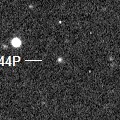
|
Now it is 18.5 mag (Oct. 19, ATLAS-MLO, Mauna Loa). It is observable at 17 mag in good condition in winter. It locates somewhat low in the Southern Hemisphere.
Date(TT) R.A. (2000) Decl. Delta r Elong. m1 Best Time(A, h)
Oct. 22 6 31.78 25 48.6 3.452 3.922 111 17.6 4:32 ( 0, 81)
Oct. 29 6 32.77 25 52.1 3.358 3.921 117 17.6 4:05 ( 0, 81)
|
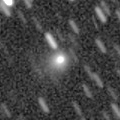
|
It brightened by 6 mag in outburst in early August up to 14.6 mag (Aug. 13, ATLAS-MLO, Mauna Loa). Now it is fading. But it is bright as 16.1 mag still now (Oct. 1, Toshihiko Ikemura, Hirohisa Sato). It stays observable in good condition for a while.
Date(TT) R.A. (2000) Decl. Delta r Elong. m1 Best Time(A, h)
Oct. 22 19 21.08 -3 8.2 1.748 1.912 83 17.6 18:41 ( 31, 47)
Oct. 29 19 34.35 -4 24.8 1.783 1.883 79 17.8 18:34 ( 33, 45)
|
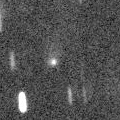
|
Now it is 17.9 mag (Oct. 19, Toshihiko Ikemura, Hirohisa Sato). It started fading before the perihelion passage. It was predicted to stay at 16 mag for a long time. But actually, it will be fainter than 18 mag soon. In the Northern Hemisphere, it stays observable in good condition for a long time. In the Southern Hemisphere, it is not observable until 2023.
Date(TT) R.A. (2000) Decl. Delta r Elong. m1 Best Time(A, h)
Oct. 22 17 56.59 45 19.1 4.127 4.067 79 17.7 18:41 (121, 57)
Oct. 29 18 3.51 42 58.9 4.195 4.091 77 17.7 18:34 (117, 54)
|
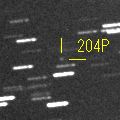
|
Now it is 18.0 mag (Oct. 16, ATLAS-MLO, Mauna Loa). It will brighten rapidly, and it will be observable at 16 mag in good condition in winter.
Date(TT) R.A. (2000) Decl. Delta r Elong. m1 Best Time(A, h)
Oct. 22 8 27.91 17 4.4 1.681 1.849 83 17.9 4:47 (302, 61)
Oct. 29 8 42.75 16 31.2 1.612 1.842 86 17.7 4:52 (310, 64)
|

|
Now it is 19.0 mag (Oct. 14, J. L. Virlichie, P. Traverse, H. Roy, G. Houdin). It is observable at 17 mag in excellent condition in winter. It is fainter than this ephemeris recently.
Date(TT) R.A. (2000) Decl. Delta r Elong. m1 Best Time(A, h)
Oct. 22 8 39.50 6 60.0 3.628 3.558 78 17.8 4:47 (311, 52)
Oct. 29 8 45.12 6 10.1 3.524 3.549 83 17.7 4:52 (321, 55)
|
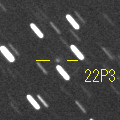
|
Now it is 17.5 mag (Oct. 1, Ken-ichi Kadota). In the Northern Hemisphere, it is observable at 17-18 mag in excellent condition in autumn. It is not observable in the Southern Hemisphere.
Date(TT) R.A. (2000) Decl. Delta r Elong. m1 Best Time(A, h)
Oct. 22 7 54.89 48 41.4 2.423 2.722 96 17.8 4:47 (218, 71)
Oct. 29 8 3.80 51 28.1 2.370 2.748 101 17.8 4:52 (202, 72)
|
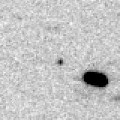
|
It stays observable at 16 mag for a long time from early 2023 to early 2024. In the Northern Hemisphere, it is observable only until 2023 spring.
Date(TT) R.A. (2000) Decl. Delta r Elong. m1 Best Time(A, h)
Oct. 22 10 29.39 10 40.9 5.281 4.751 53 17.9 4:47 (282, 34)
Oct. 29 10 31.35 9 41.4 5.144 4.715 59 17.8 4:52 (288, 40)
|
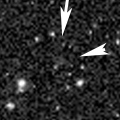
|
Now it is 17.5 mag (Oct. 2, ATLAS South Africa). Very far object. It stays 18 mag for a long time from 2021 to 2026. In the Southern Hemisphere, it stays observable in good condition for a long time. In the Northern Hemisphere, it is not observable at all.
Date(TT) R.A. (2000) Decl. Delta r Elong. m1 Best Time(A, h)
Oct. 22 8 19.66 -70 6.8 10.702 10.521 76 17.9 4:47 (352,-16)
Oct. 29 8 17.33 -70 57.7 10.692 10.513 77 17.9 4:52 (355,-16)
|
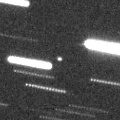
|
Now it is 17.1 mag (Oct. 1, Toshihiko Ikemura, Hirohisa Sato). In 2022, it stays observable at 17 mag for a long time.
Date(TT) R.A. (2000) Decl. Delta r Elong. m1 Best Time(A, h)
Oct. 22 8 10.85 21 36.0 0.777 1.242 88 17.9 4:47 (301, 67)
Oct. 29 8 18.83 20 48.5 0.784 1.298 93 17.9 4:52 (314, 71)
|
|
![]()
 117P/Helin-Roman-Alu 1
117P/Helin-Roman-Alu 1 C/2020 R7 ( ATLAS )
C/2020 R7 ( ATLAS ) 22P/Kopff
22P/Kopff C/2022 A2 ( PanSTARRS )
C/2022 A2 ( PanSTARRS ) C/2021 X1 ( Maury-Attard )
C/2021 X1 ( Maury-Attard ) C/2020 S4 ( PanSTARRS )
C/2020 S4 ( PanSTARRS ) 71P/Clark
71P/Clark 116P/Wild 4
116P/Wild 4 P/2022 L3 ( ATLAS )
P/2022 L3 ( ATLAS ) C/2020 Y2 ( ATLAS )
C/2020 Y2 ( ATLAS ) 119P/Parker-Hartley
119P/Parker-Hartley C/2021 T4 ( Lemmon )
C/2021 T4 ( Lemmon ) 61P/Shajn-Schaldach
61P/Shajn-Schaldach (65803) Didymos
(65803) Didymos C/2021 G2 ( ATLAS )
C/2021 G2 ( ATLAS ) 408P/2020 M7 ( Novichonok-Gerke )
408P/2020 M7 ( Novichonok-Gerke ) C/2021 S3 ( PanSTARRS )
C/2021 S3 ( PanSTARRS ) 327P/Van Ness
327P/Van Ness 157P/Tritton
157P/Tritton 9P/Tempel 1
9P/Tempel 1 44P/Reinmuth 2
44P/Reinmuth 2 395P/2020 H1 ( Catalina-NEAT )
395P/2020 H1 ( Catalina-NEAT ) C/2020 F5 ( MASTER )
C/2020 F5 ( MASTER ) 77P/Longmore
77P/Longmore 246P/NEAT
246P/NEAT C/2021 C5 ( PanSTARRS )
C/2021 C5 ( PanSTARRS ) C/2019 F1 ( ATLAS-Africano )
C/2019 F1 ( ATLAS-Africano ) C/2019 O3 ( Palomar )
C/2019 O3 ( Palomar ) P/2021 N2 ( Fuls )
P/2021 N2 ( Fuls ) C/2019 T3 ( ATLAS )
C/2019 T3 ( ATLAS ) C/2020 H6 ( ATLAS )
C/2020 H6 ( ATLAS ) C/2022 E2 ( ATLAS )
C/2022 E2 ( ATLAS ) P/2022 P2 ( ZTF )
P/2022 P2 ( ZTF ) C/2022 Q2 ( ATLAS )
C/2022 Q2 ( ATLAS ) C/2022 L2 ( ATLAS )
C/2022 L2 ( ATLAS ) 402P/2020 Q3 ( LINEAR )
402P/2020 Q3 ( LINEAR ) (3200) Phaethon
(3200) Phaethon C/2021 QM45 ( PanSTARRS )
C/2021 QM45 ( PanSTARRS ) C/2020 U4 ( PanSTARRS )
C/2020 U4 ( PanSTARRS ) C/2020 J1 ( SONEAR )
C/2020 J1 ( SONEAR ) C/2022 S3 ( PanSTARRS )
C/2022 S3 ( PanSTARRS ) 244P/Scotti
244P/Scotti 285P/LINEAR
285P/LINEAR C/2020 U5 ( PanSTARRS )
C/2020 U5 ( PanSTARRS ) 204P/LINEAR-NEAT
204P/LINEAR-NEAT P/2021 V2 ( Fuls )
P/2021 V2 ( Fuls ) C/2022 P3 ( ZTF )
C/2022 P3 ( ZTF ) C/2022 A3 ( Lemmon-ATLAS )
C/2022 A3 ( Lemmon-ATLAS ) C/2019 E3 ( ATLAS )
C/2019 E3 ( ATLAS ) 107P/(4015) Wilson-Harrington
107P/(4015) Wilson-Harrington![]()
































































